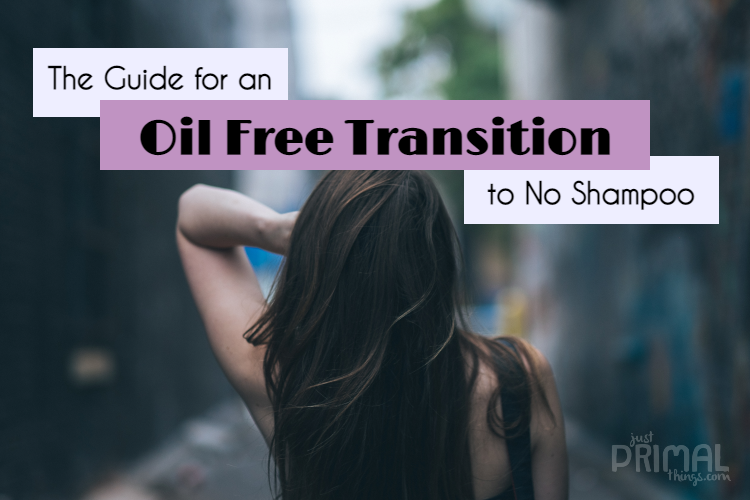
This post is all about the initial oily transition phase many people experience when switching from shampoo to No Poo. Keep reading to learn what is the oily transition phase, how long does it last, tips for training the scalp to slow oil production, and how to get through the No Poo transition phase. (Beginners start here.)
What is the No Poo Transition Phase?
For years, many of us have been over-washing our hair with harsh shampoos that strip the natural oils from our hair and scalp. Over-washing leaves the scalp dry, so the scalp kicks into overdrive to produce more oils to compensate. The excess oil production quickly makes our hair look oily, so we shampoo again to remove the excess oil. Shampoo gets people stuck in a cycle of over-washing and excess oil production, but this cycle can be broken by switching to a gentler cleansing method.
It’s important to note that starting No Poo or gentle hair washing methods is not cause of this excess oil production. Instead, the initial absence of shampoo highlights just how bad the issue has become… because of shampoo. (More on why shampoo is bad for hair.)
The benefits of getting past the Transition Phase
One of the major benefits of going shampoo-free is that the scalp stops being stripped of all its natural oils, so the scalp can slow down oil production.
The benefits of slowing scalp oil production:
- Hair can look cleaner for longer, so it doesn’t have to be washed as often.
- Less time and money can be spent on hair care
- Hair won’t have to be damaged with heat styling as often (if using a hair dryer every time it’s wet)
- Even the very gentlest No Poo hair washing methods can get hair clean, without having to cut through excess amounts of oil for every wash
- A small amount of natural oils can stay on hair which makes hair soft, hydrated, and frizz-free – without looking oily.
How long does the Transition Phase last?
It can take time for the scalp to get used to gentler hair washing methods before slowing down oil production. For some people, the oily transition phase lasts a week or two. (This was the case for me.) For others, this phase can take longer, depending on many factors, including how frequently hair was over-washed, the harshness of the cleanser, and how recently the harsh cleaner was being used.
How to get through the No Poo Transition Phase

I have found the two most important rules to follow to encourage the scalp to slow the excess oil production are:
Step 1: Stop stripping natural oils off the scalp with harsh, overly-cleansing shampoos
This can be solved simply by switching to a gentler hair washing method in place of shampoos. For a list of gentle hair washing methods, how they compare, and tips for how to choose a method, check out this post.
Step 2: Wash hair less often to allow natural oils to nourish the scalp
This can be solved a couple of ways. Firstly, avoid washing hair purely out of routine, and wait to wash it when it looks or feels oily. (Or if there are other factors involved that make hair dirty like being in nature, swimming, etc.) If hair doesn’t look or feel like it needs to be washed, then it probably doesn’t need to be! Instead, consider skipping a hair wash or just rinse hair.
Secondly, when hair does start to look or feel oily, consider waiting a little longer between washes. Even waiting an extra half day can make some difference if you can’t wait a whole day. For example, if hair looks a little oily a night, consider waiting until at least the next morning to wash it.
How to transition quickly without looking oily
I have a dedicated post for you with tips and techniques for how to get through the transition phase without looking oily. Check out my transition tips here – Seriously!
How to gradually transition without looking oily
You may also want to check out my post how to gradually transition to No Poo that uses a Low Poo in combination with No Shampoo methods to cut through excess oil and remove buildup.
Considerations for the Transition Phase

Ultimately when getting through the No Poo transition phase, do what’s right for you and your personal preferences, and assess when it’s time to wash your hair. Hopefully the information above empowers you to get through the initial oily phase at a pace that is comfortable to you.
Everyone’s starting point, oil production, and experience with the transition phase is different. How much oil being produced and how long this phase lasts depends on a multitude of factors. Some of it depends on how frequently hair was over-washed, the harshness of the cleanser, and how recently the harsh cleaner was being used. Oil production is also dependent on factors such as age and genetics.
Please be kind to and patient with yourself while your scalp recovers from harsh cleansers!
Troubleshooting the No Poo Transition Phase
Tips and techniques for how to get through the transition phase without looking oily: Check out the dedicated post with tips here.
If you have trouble getting your hair clean without shampoo during the transition phase: Check out the post how to gradually transition to No Poo without looking oily and without waxy buildup.
If you think you should be past the transition phase by now: Your scalp may have already slowed down oil production!! But all the excess oils during the transition phase may have left some oily/waxy buildup on your hair. Check out this post for how to quickly and easily solve oily/waxy buildup that may be causing the issue, and then you can continue with glorious No Poo hair.
You can also check out the No Poo eBook for more tips and troubleshooting.



